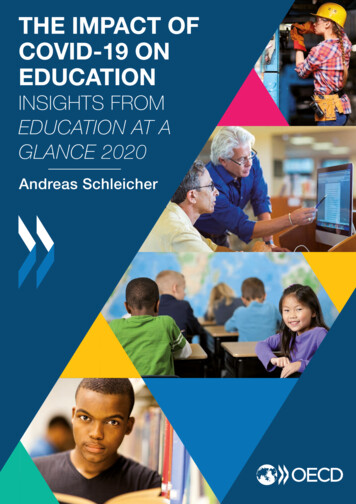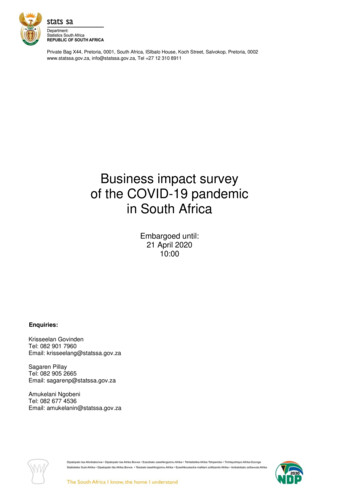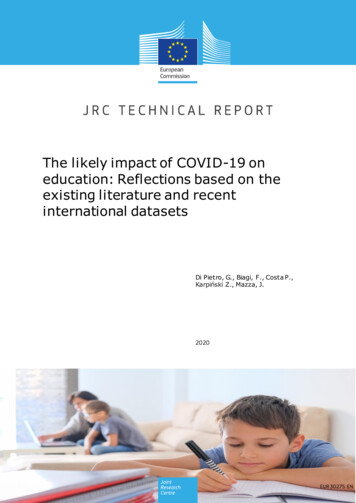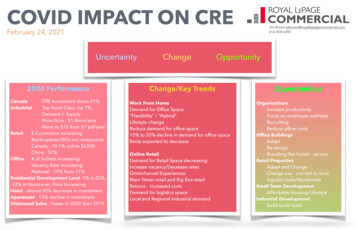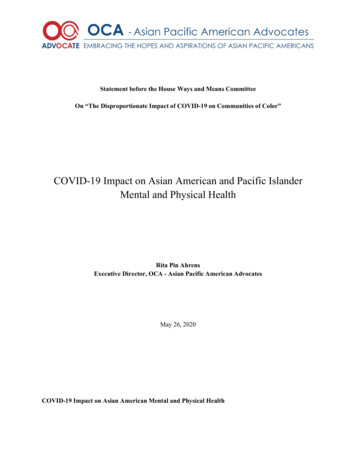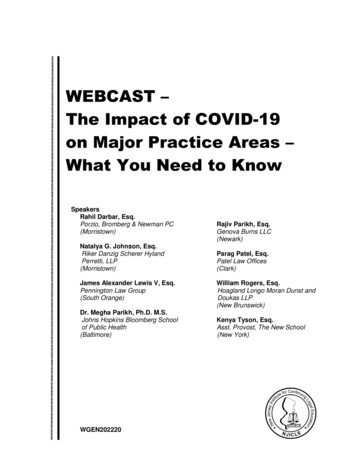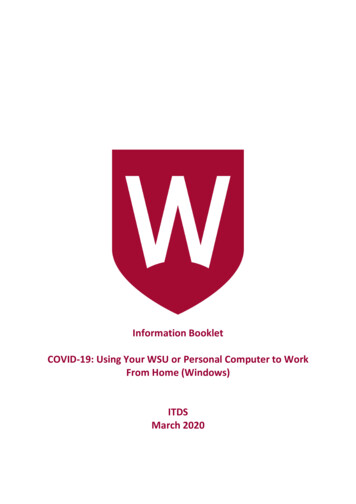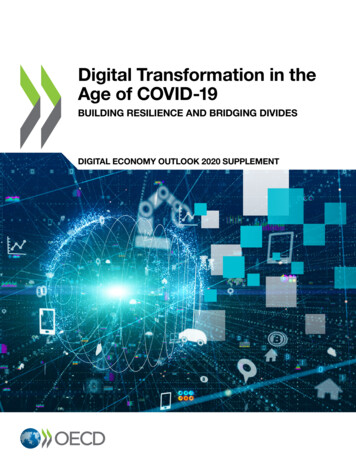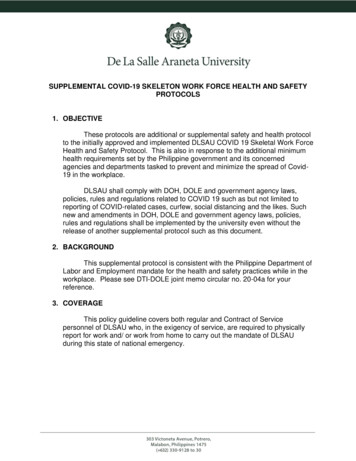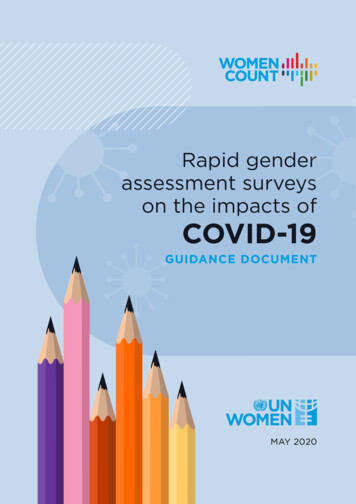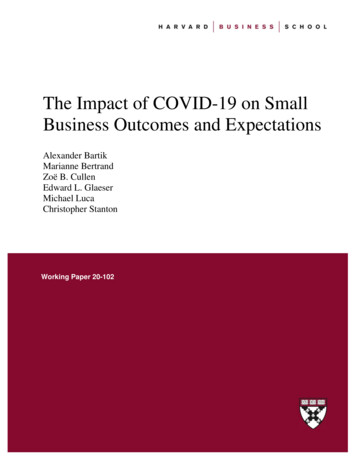
Transcription
The Impact of COVID-19 on SmallBusiness Outcomes and ExpectationsAlexander BartikMarianne BertrandZoë B. CullenEdward L. GlaeserMichael LucaChristopher StantonWorking Paper 20-102
The Impact of COVID-19 onSmall Business Outcomes andExpectationsAlexander BartikEdward L. GlaeserUniversity of IllinoisHarvard UniversityMarianne BertrandMichael LucaUniversity of ChicagoHarvard Business SchoolZoë B. CullenChristopher StantonHarvard Business SchoolHarvard Business SchoolWorking Paper 20-102Copyright 2020 by Alexander Bartik, Marianne Bertrand, Zoë B. Cullen, Edward L. Glaeser, Michael Luca, andChristopher Stanton.Working papers are in draft form. This working paper is distributed for purposes of comment and discussion only. It maynot be reproduced without permission of the copyright holder. Copies of working papers are available from the author.Funding for this research was provided in part by Harvard Business School.
The impact of COVID-19 on small business outcomes and expectations*Alexander W. Bartik, Marianne Bertrand, Zoe Cullen, Edward L. Glaeser, Michael Luca, andChristopher StantonAbstractTo explore the impact of COVID on small businesses, we conducted a survey of more than 5,800small businesses between March 28 and April 4, 2020. Several themes emerged. First, mass layoffsand closures had already occurred – just a few weeks into the crisis. Second, the risk of closurewas negatively associated with the expected length of the crisis. Moreover, businesses had widelyvarying beliefs about the likely duration of COVID-related disruptions. Third, many smallbusinesses are financially fragile: the median business with more than 10,000 in monthlyexpenses had only about two weeks of cash on hand at the time of the survey. Fourth, the majorityof businesses planned to seek funding through the CARES act. However, many anticipatedproblems with accessing the program, such as bureaucratic hassles and difficulties establishingeligibility. Using experimental variation, we also assess take-up rates and business resilienceeffects for loans relative to grants-based programs.*We thank Karen Mills for connecting us to the leaders at Alignable and to Eric Groves, Venkat Krishnamurthy,and Geoff Cramer for immense help in facilitating survey distribution. Dylan Balla-Elliott, Manal Saleh, andPratyush Tiwari provided excellent research assistance. Author contact information is: Alexander Bartik is at theUniversity of Illinois: abartik@illinois.edu, Marianne Bertrand is at the University of Chicago Booth School ofBusiness: Marianne.Bertrand@chicagobooth.edu, Zoe Cullen is at Harvard Business School: zcullen@hbs.edu, EdGlaeser is at the Harvard Department of Economics: eglaeser@harvard.edu, Michael Luca is at Harvard BusinessSchool: mluca@hbs.edu, and Christopher Stanton is at Harvard Business School: cstanton@hbs.edu.1
1. IntroductionIn addition to its impact on public health, COVID-19 has caused a major economicshock. In this paper, we explore the impact of COVID-19 on the small business landscape in theUnited States, focusing on three questions. First, how did small businesses adjust to theeconomic disruptions resulting from COVID-19? Second, how long did businesses expect thecrisis to last, and how do expectations affect their decisions? Third, how might alternative policyproposals impact business and employment resilience?To explore, we surveyed more than 5,800 small businesses that are members ofAlignable, a network of 4.6 million small businesses. The survey was conducted between March28 and April 4, 2020. The timing of the survey allows us to understand expectations of businessowners at a critical point in time when both the progression of COVID-19 and the government’sresponse were quite uncertain.The results suggest that the pandemic had already caused massive dislocation amongsmall businesses just several weeks after its onset and prior to the availability of government aidthrough the CARES Act. Across the full sample, 43 percent of businesses had temporarily closedand nearly all of these closures were due to COVID-19. Respondents that had temporarily closedlargely pointed to reductions in demand and employee health concerns as the reasons for closure,with disruptions in the supply chain being less of a factor. On average, the businesses reportedhaving reduced their active employment by 39 percent since January. The decline wasparticularly sharp in the Mid-Atlantic region (which includes New York City), where 54 percentof firms were closed and employment was down by 47 percent. Impacts also varied acrossindustries, with retail, arts and entertainment, personal services, food services, and hospitalitybusinesses all reporting employment declines exceeding 50 percent; in contrast, finance,professional services, and real estate related businesses experienced less disruption, as theseindustries were better able to move to remote production.Our results also highlight the financial fragility of many small businesses. The medianfirm with expenses over 10,000 per month had only enough cash on hand to last approximatelytwo weeks. Three-quarters of respondents reported that they only had enough cash on hand to2
cover two months of expenses or less†. Not surprisingly, firms with more cash on hand weremore optimistic that they would remain open by the end of the year.Our survey also elicited businesses’ beliefs about the evolution of the crisis, allowing usto study the role of beliefs and expectations on decisions. The median business owner expectedthe dislocation to last well into mid-summer, as 50% of respondents believed that the crisiswould last at least until the middle of June. However, beliefs about the likely duration of thecrisis varied widely. This raises the possibility that some firms were making mistakes in theirforecasts of how long the crisis will last.‡The crisis duration plays a central role in the total potential impact. For a crisis lasting 4months instead of 1 month, only 47% of businesses expected to be open in December comparedto 72% under the shorter duration. There is also considerable heterogeneity in how sensitivebusinesses are to the crisis. In-person industries like personal services or retail reported muchlower prospects for riding out the pandemic than professional services or other sectors withminimal need for face-to-face contact.Lastly, our analysis explores variants of stimulus packages that were being discussed atthe time of the survey. The results show that over 70% of respondents anticipated takingadvantage of aid when asked about a program that resembles the Paycheck Protection Program(PPP) that is part of the CARES act. Moreover, they expected this funding to influence otherbusiness decisions – including layoff decisions and staying in business altogether. At the sametime, many businesses were reluctant to apply for funding through the CARES Act because ofconcerns about administrative complexity and eligibility. A large number of respondents alsoanticipated problems with accessing the aid, citing potential issues such as bureaucratic hasslesand difficulties establishing eligibility.Our survey was constructed to allow for a counterfactual evaluation of a straight loanpolicy, which is a stylized representation of traditional SBA disaster relief programs. While themore generous PPP program does improve take-up and business outcomes, traditional loans withspeedy delivery and sufficient liquidity are also found to meaningfully shift business owners’expectations about survival. When compared to a straight loan without forgiveness provisions,†See Faulkender (2002), La Rocca et al (2019) for discussions of cash holdings of small businesses.See Goldfarb and Xiao (2011), DellaVigna and Gentzkow (2019), Strulov-Shain (2019) for a related literature onthe behavioral economics of firm decisions.‡3
the CARES act had modestly greater take-up, but at much higher cost to the government.Because the majority of business owners would have taken up aid in the form of less generousloans, our results suggest that liquidity provision was paramount for these owners.Overall, our paper contributes to our understanding of the economic impact of COVID19 on the small business ecosystem. The fate of the 48% of American workers who work insmall businesses is closely tied to the resilience of the small business ecosystem to the massiveeconomic disruption caused by the pandemic. Our survey, which was conducted during a periodof substantial policy uncertainty and before any federal response had been enacted, provides aunique snapshot into business decisions and expectations at that time, while offering insight forpolicy designed to aid the recovery. Our results help quantify how the length of the crisis willdetermine its ultimate impact, which policy makers should consider as they contemplate the scaleof the required interventions. We estimate that closures alone might lead to 32.7 million joblosses if the crisis lasts for four months and 35.1 million job losses if the crisis lasts for sixmonths. While some of these workers will surely find new jobs, these projections suggest thatthe scale of job dislocation could be larger than anything America has experienced since theGreat Depression and larger than the impact of the 1918 influenza epidemic found by Barro,Ursua and Weng (2020) and Garrett (2007, 2008). Another important take-away of our work isthat during liquidity crunches with significant cash flow disruptions, the form of cash injection(e.g. grant vs. loan) may be less important than making sure that funding is rapidly available withlittle administrative complexity.§The rest of the paper proceeds as follows. Section 2 discusses the survey design. Section3 discusses the characteristics of the firms that responded to the survey and theirrepresentativeness. In Section 4, we explore the current and expected impacts of COVID-19 onthese businesses. In Section 5, we present results from a module of the survey thatexperimentally varies policy proposals, allowing us to explore responses to policies such as therecently passed CARES Act as well as alternative policies. Section 6 considers survival ratedifferences across industries, and how survival depends on the duration of the crisis. Weconclude in Section 7.§This echoes a growing literature that suggests that reducing simplifying or providing assistance in the process ofsigning up for programs can increase take-up. For examples, see Bettinger et al (2012) and Finkelstein andNotowidigdo (2019).4
2. Survey Design and DetailsOur survey was sent out in partnership with Alignable, a network-based platform focusedon the small business ecosystem. Alignable enables businesses to share knowledge and interactwith one another, and currently has a network of 4.6 million small businesses across NorthAmerica. Much of the network growth has been organic, with little outside marketing.Alignable also regularly sends out polls (which they call “pulse surveys”) to users. At theend of a regular pulse poll, participants who took that poll received an email inviting them toparticipate in a more comprehensive survey being conducted by researchers at Harvard BusinessSchool. Appendix 1 shows the message seen by respondents who opted to participate in theadditional survey. Participants were shown a disclosure statement and consent protocol. Nopayments were offered; participation was completely voluntary.We received 7,511 responses between March 27 and April 4. 5,843 of these can be tracedback to U.S. based businesses, which is the relevant sample for understanding policy. While the7,511 responses represent a small fraction (.017 percent) of Alignable’s total membership, itrepresents a much larger share of Alignable’s membership that has engaged with their weeklypulse surveys on COVID-19. Alignable estimates that 50,000-70,000 members are taking thesepulse surveys weekly, which suggests a 10 - 15 percent conversion rate of these more activerespondents.Our sample, therefore, is selected in three ways: (1) they are firms that have chosen tojoin Alignable, (2) they are Alignable firms that have chosen to stay actively engaged takingsurveys, and (3) they are the set of firms that are active within Alignable that chose to answer oursurvey. Consequently, there are many reasons to be cautious when extrapolating to the entireuniverse of America’s small businesses. We will discuss their representativeness based onobservable attributes in the next section of this report.The survey included a total of 43 questions, with basic information about firmcharacteristics (including firm-size and industry), questions about the current response to theCOVID-19 crisis, and beliefs about the future course of the crisis. Some questions were onlydisplayed based on skip logic, so most participants responded to fewer questions. The surveyalso includes an experimental module that randomized scenarios between respondents tounderstand how different federal policies might impact these firms’ behavior and survival as thecrisis unfolds. Specifically, we experimentally varied some of the descriptions of potential5
policies across the sample to shed light on the potential impact of policy initiatives that, at thetime, were very uncertain. We will discuss that module more thoroughly in Section V. A furtherexperimental module included between-respondent randomization which explored decisionsunder different hypothetical durations of the crisis.3. Firm Characteristics and RepresentativenessThe survey contains three baseline questions which enable us to assess therepresentativeness of the sample along observable dimensions: number of employees, typicalexpenses (as of January 31, 2020), and share of expenses that go towards payroll. We are alsoable to get rough information about geolocation to assess representativeness by state.We compare our data with data on businesses from the 2017 Census of US Businesses,using the publicly available s
04.04.2020 · The impact of COVID-19 on small business outcomes and expectations * Alexander W. Bartik, Marianne Bertrand, Zoe Cullen, Edward L. Glaeser, Michael Luca, and Christopher Stanton Abstract To explore the impact of COVID on small businesses, we conducted a survey of more than 5,800 small businesses between March 28 and April 4, 2020. Several themes emerged. First, mass
